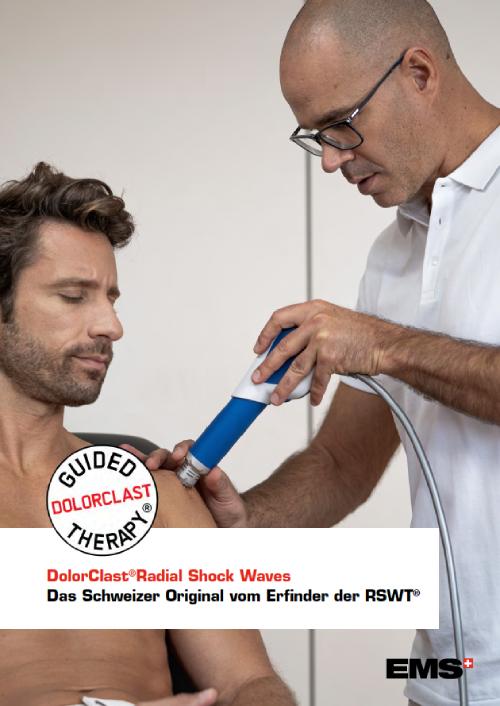
GUIDED DOLORCLAST® THERAPY

Pain management in musculoskeletal disorders.
Guided DolorClast® Therapy (GDT) is a new treatment concept that combines manual therapy, laser therapy & shockwave therapy to treat 90% of your patients (musculoskeletal disorders) successfully, quickly and safely.
WHY Guided Dolorclast® Therapy?
- Satisfied patients
- Optimal treatment results
- Increases practice success
6 STEPS + 1 GOAL = PAIN-FREE PATIENTS

Medical history & patient retention

Medical history
In order to ensure a 100% patient-centered, successful treatment, an accurate medical history is necessary to rule out contraindications to GDT.
Medical examinations
Establish or confirm a diagnosis through a thorough examination of the patient including palpation, functional testing, and observation of range of motion (ROM) development.
Pain assessment
To track the success of treatment, use a visual analog scale (VAS) for pain assessment before the first treatment.
DolorClast® High Power Laser

No opioids
No sedatives
No pain
Musculoskeletal injuries are described by patients as very painful, especially in the acute phase. Unfortunately, despite the risk of side effects, opioids or sedatives are still prescribed too frequently. To avoid any form of pain treatment, EMS has developed the DolorClast® high-power laser to provide a non-invasive, effective and safe solution for patients suffering from acute phases or with a low pain tolerance threshold.
Analgesic effect:
Sets in 5 minutes after the end of laser treatment and lasts up to 72 hours.
Anti-inflammatory effect:
Decrease in acute inflammation and consequently rapid resolution of edema and a faster healing process of the damaged tissue.

E-Book about the DolorClast®
High Power Laser

DolorClast® Radial Shockwave


E-book on shock wave therapy with the DolorClast® Radial Shock Waves

What are the benefits of shock wave therapy?
Extracorporeal shock wave therapy (ESWT) is the application of shock waves in medicine.
It is clinically proven that pressure waves acting on injured tissue stimulate metabolic reactions.
- Reduction of pain sensation of nerve fibers.
- Increase of blood circulation in the surrounding soft tissues.
- Start of the healing process triggered by the activation of stem cells.
The more energy is introduced into the tissue, the better the therapeutic result.
RADIAL SHOCK WAVE THERAPY (rESWT)
The ballistic principle uses compressed air to accelerate a projectile at high speed (up to 90 km/h), which hits a fixed applicator. The kinetic energy is converted into a pressure wave, which then penetrates radially into the target tissue. This energy creates cavitation bubbles in the tissue, which start the healing process in the damaged tissue.
Focused Shock Wave Therapy

The Focused Shock Wave Therapy is successfully used for:
- Deep indications, such as calcifying tendinitis of the shoulder.
- Subacute or chronic pathologies
- Deep calcified lesions or myotendinous tears, fractures or enthesopathies of the elbow that refuse to heal.
Which shock waves are most effective?
In both focused and radial ESWT, an ED+ of 0.4 mJ/mm2 can be achieved, which has been clinically shown to be sufficient for almost all musculoskeletal and skin ESWT indications.
Focused Shock Wave Therapy (fESWT)
The piezoceramic principle works by applying a high voltage to 1,000 piezocrystals. The twitching of these crystals generates a pressure wave that penetrates the tissue and meets in a cigar-shaped focal point. The penetration depth is precisely determined via various GelPads.

E-Book on shock wave therapy with the DolorClast® SWISS PIEZOCLAST

Rehabilitation

Guided DolorClast® Therapy is based on the combination of different therapies with the aim of relieving pain and healing musculoskeletal injuries. In addition to DolorClast® laser and shockwave treatments, its strength also lies in a rehabilitation program that accelerates and improves recovery of function. The rehabilitation program is designed at the discretion of each practitioner depending on their habits and the material they have in their practice.
GDT invites practitioners to include patients in their treatment routine and be a player in their recovery. Adding rehabilitation exercises to DolorClast® laser and shockwave treatments will improve clinical outcomes.
Aftercare

Patient compliance for treatments that last over a few weeks is difficult. GDT helps you keep patients in your practice and improve your overall success. Here are some helps for your patients:
Track treatment success
via outcome measurement tools
(VAS score and ROM) to reassure your patients of their treatment progress.
Schedule the next appointment
Before the patient leaves the hospital to establish a treatment pattern
Don’t forget.
Patients are often your most passionate ambassadors. Their experiences with GDT mean more than any paid campaign for your practice.
So engage in the discussion with your patients and make them feel good about their treatment and results.
You can find more information about Guided Dolorclast® Therapy here.
Dolorclast® High Power Laser

Dolorclast® radial shock wave

PIEZOClast®




